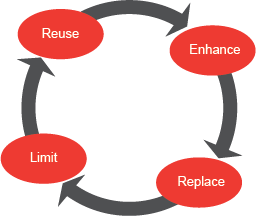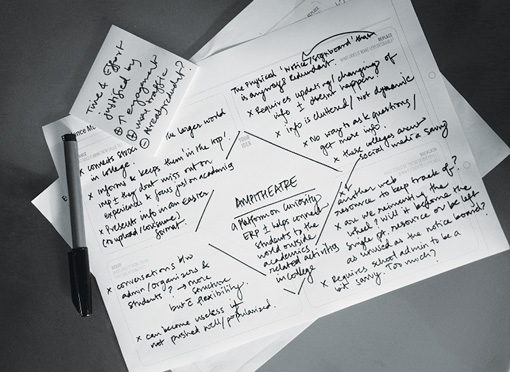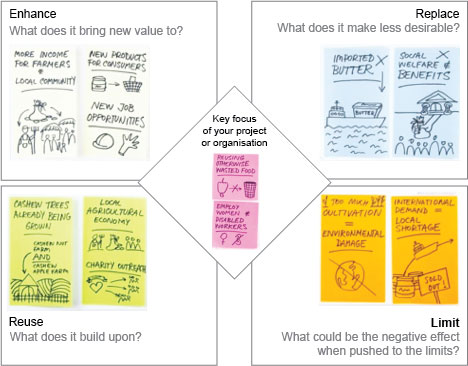Use 'Print preview' to check the number of pages and printer settings.
Print functionality varies between browsers.
Printable page generated Friday, 26 April 2024, 1:50 PM
Evidence Planning
Evidence Planning
This module has been written to support your understanding and use of the Evidence Planning Tool from the DIY Toolkit. You should look at the Evidence Planning Template before working through the module. You will find it helpful to have a print out of the Evidence Planning Template (which can be found on page 10 of the DIY Toolkit) with you while you work through this module.
Sometimes we need a quick way to reconnect with the goal of a project in order to improve the chances of realising it. The Evidence Planning Tool helps you to re-examine why you are doing what you do, and whether your approach is the best one. It helps to reveal the assumptions and evidence upon which you are basing your present pathway. It also challenges you to think about the impact of your project, helping you to construct an evidence-based case for the effect you want to have.
This module will help you to understand why evidence planning is used, and how you can apply it in your own context to gain insight that will help you move forward your project or other activity.
Learning outcomes
After studying this module, you should be able to:
- describe what evidence planning is and when you would use it (SAQ 1)
- understand the Evidence Planning Tool and its usefulness for constructing an evidence base for the impact of a project, organisation or business (SAQ 2)
- explain the difference between implicit and explicit assumptions (SAQ 3)
- use evidence planning to identify your mistakes, and what you want to retain and change (SAQ 4).
1 What is evidence planning? When would you use it?
The Evidence Planning Tool is a simple framework that helps you to define, share and improve what you are trying to do. By making you think more broadly about your work’s effect on target beneficiaries, society, other activities and organisations, evidence planning helps you construct an evidence-based case for the impact you want to have.
The tool is valuable because it can help you determine whether there are alternative approaches or processes that will enable you to realise your goal more effectively. Such reflection can build confidence that you are having the desired impact and achieving it efficiently.
You might use the tool as part of ongoing monitoring and evaluation of a project or programme, or because you feel that engaging with the assumptions and evidence will help focus your approach.
The tool can also be used if you think that the way you are working is outdated or not fit for purpose. This was why Tarun, the Education Director of the Teemac Project, decided to use the tool, as explained in Case Study 1. (You can read the full case study about Tarun’s Teemac project on page 15 of the DIY Toolkit.)
Case Study 1: Introducing Teemac
Teemac works with educational institutions, creating products to help them modernise practices through an enterprise resource planning (ERP) platform called Curiosity.
The problem
Tarun says:
We are currently working on a feature called Amphitheater which connects college students to extra-curricular activities and events happening in their college. Right now most of the institutions we work with have an ‘age-old’ bulletin board with ad-hoc, outdated information and no one point where students or college admin can access or update information.
Why the tool was used
Tarun says:
We had realised that we are very idealistic when it comes to building features within the Curiosity platform. We usually follow our gut instinct, even when the institutions do not see an explicit value in them. For a change, we thought we would adopt a more evidence-based approach before we start building the Amphitheater feature.
We used a combination of problem definition (see page 40 of the DIY Toolkit) and evidence planning. This was to both define and create a logical evidence based plan for the problem we are trying to solve.
So, the Evidence Planning Tool can be used to shake things up, and reawaken a creative approach to problem solving, as represented comically in Figure 1.

Activity 1
Reflect on:
- the key focus of a project, organisation or business you are working with at the moment
- the approach taken to realise it.
Do you feel this is the best approach? If not, why?
Discussion
It probably isn’t difficult for any of us to think of things that we, our organisation or business could do differently to achieve better outcomes. Critiquing an approach is easier than identifying why that approach is followed. To understand the latter, we need to engage with the evidence base for the approach.
2 The Evidence Planning Tool approach
The Evidence Planning Tool enables you to look ahead to the impact of your work to consider whether the assumptions you are making are correct. Figure 2 shows a representation of the flow for gathering information using the Evidence Planning Tool.

(Please refer to your print out or open a copy of the Evidence Planning Template from the website for the following discussion explaining the Evidence Planning Template. )
The key focus for the project, organisation or business is written in the middle of the template. Then each of the surrounding quadrants is completed; enhance, replace, limit and reuse. Note: there could be multiple entries in any of the quadrants. Table 1 explains the template in more detail.
| Enhance | Here you focus on what your project, organisation or business improves or enhances. For example:
|
| Replace | Here you ask what your project, organisation or business replaces. For example:
|
| Limit | Here you identify what your project, organisation or business limits. For example:
|
| Reuse | Here you ask what the project or organisation builds upon. For example:
|
2.1 Implicit and explicit assumptions
Working through the tool will involve gathering evidence. You are likely to have made assumptions about your evidence, and it’s important to reflect on and test these assumptions, whether they are implicit (also known as tacit) or explicit assumptions.
- Implicit assumptions are those that haven’t been articulated. We make implicit assumptions based on our personal experience and position, often without even realising that that’s what we’re doing. For example, if your organisation works with a mixture of paid employees and volunteers, there could be an implicit assumption for many that the paid employees are the real experts and therefore somehow ‘better’ at their role. Implicit assumptions are generally harder to identify and require some honest self-awareness.
- Explicit assumptions are those that have been expressed and shared. For example, if your organisation has a policy of using paid employees to check the work of volunteers, this is based on an expressed assumption that volunteers are less skilled and experienced than paid employees. This explicit assumption is likely to be drawn from experience, where the majority of volunteers are perhaps young and at an early stage in their careers.
Key point
Evidence planning provides the opportunity to test all the assumptions that have been made within the justification for your project or activity.
Activity 2
Identify the correct implicit assumption in each of the following statements:
a.
Using a mobile phone in church is right.
b.
If other people do something, it can’t be wrong.
The correct answer is b.
a.
There are no real people behind the facade of the bank.
b.
Stealing is alright in some circumstances.
The correct answer is a.
a.
Students should not fail.
b.
We should not damage students’ self-confidence.
The correct answer is b.
a.
Only people who are dating hold hands.
b.
Only a boy and a girl can date.
The correct answer is a.
a.
He didn’t say anything because he can’t speak.
b.
The only reason for not talking about something is lack of knowledge.
The correct answer is b.
a.
People only engage with our website when they can find it.
b.
If people were finding our website, they would be engaging with it.
The correct answer is b.
2.2 Case study: using the tool
Returning to the Teemac Case Study, Figure 3 and Case Study 2 show how the tool was used.
Case Study 2: How Teemac used the tool
Tarun says:
Two of my team mates and I printed out the worksheets and sat around a table with our notes and thoughts. The Evidence Planning worksheet was surprisingly interesting. When we started filling it out, we realised that we weren’t convinced of the evidence backing the solution as well as the impact it could create. We ended up slightly confused about the direction and found ourselves arguing amongst each other. We haven’t found the answers yet, but it’s still definitely a positive outcome.
Activity 3
In Case Study 2, the Evidence Planning Tool revealed that the evidence backing the solution was not convincing. What do you think that Tarun’s team meant by this? How do you feel about them arguing amongst themselves?
Discussion
Convincing evidence should be:
- relevant to the goal or problem
- objective (is it factual or based on opinion?)
- transparent on how and who collected the evidence (is the method and data-gathering appropriate and robust?)
- current (is it up to date?).
Arguing sounds destructive, and it can be, but in this situation it sounds as though it provided an opportunity to explore contested understandings of the issue along with the evidence and assumptions that underpinned it. Arguments don't need to be heated or feel uncomfortable as long as everyone is professional. It is important to focus on what others are saying, rather than the people themselves, and to avoid being positional.
3 Applying the Evidence Planning Tool
In the examples given previously, you may have recognised that the impact of a project can be felt at different levels; for example:
- global
- societal
- community
- organisational
- business
- individual.
For the Evidence Planning Tool to be thorough, you will need to consider the effect that your work could have at each of these levels for each quadrant. Table 2 below gives a checklist to ensure your thinking is as wide as it can be.
| Check for impact on: | By asking: |
| The wider world | What impact will it have on the global market, the environment, society? |
| A particular field or area of interest | What impact will it have on a particular sector or practice? |
| The beneficiaries | What impacts will it have on beneficiaries, consumers, user groups, employees or the community? |
| Your work | What impact will it have on your work/life? |
3.1 Case study: fruit in West Africa
Case Study 3 summarises how the Evidence Planning Tool was used by a fruit company in West Africa.
Case Study 3: Evidence planning for decision making in West Africa
Randa is the chief executive of a fruit company in West Africa. She saw commercial potential when she learned that local farmers produced cashew nuts for export, but did nothing with the fruit from the cashew trees. Her company began to produce butter made from cashew apples. The business grew fast and Randa wanted to be clear about the wider effects of the company’s work.
Using the Evidence Planning Template, Randa looked at the impact of this work from different points of view. She began by filling out the main focus of her company, which was to employ women and disabled workers to repurpose otherwise wasted food. The four boxes around her key focus helped Randa to reflect on the key changes that her work could make in the agricultural sector, as well as the impact it could have on society.
She thought about what her company’s offering enhanced. She identified:
- more income for farmers and the local community
- new products for consumers
- new job opportunities.
Then she thought about what it replaced:
- imported butter
- social welfare benefits.
Next, she thought about what it limited:
- international demand could lead to local shortages
- over-cultivation could cause environmental damage.
Finally, she thought about what it reused or built on:
- cashew trees were already grown for nuts, but now fruit was also harvested
- the work added to the local agricultural economy
- the work provided charity outreach.
Looking ahead, Randa could see the wider impact of her company on local farmers, the community, the environment and the economy. This is shown in Figure 4.

Randa could also see how this might change in the future. She now has a better understanding of her company’s strengths and weaknesses and where she can improve. Randa’s completed template is shown in Figure 5.
3.2 Applying evidence planning to your own work
You are now ready to apply the Evidence Planning Tool to your own project, organisation or business.
Activity 4
Complete the Evidence Planning Template for a project, organisation or business with which you are familiar. If you need help, look back to the completed templates from the two case studies featured in this module.
Discussion
The Teemac case study perhaps reassured you that completing the tool template can be a challenge. Remember that you can adapt the tool for your own use. For example, when considering what your offering enhances, as well as the template question: What does it bring new value to?, you might broaden the understanding of value beyond financial value to value in terms of people, places and/or the environment.
4 Reviewing your results
The purpose of the Evidence Planning Tool is to reveal the impact of your work. This helps you identify what is working well and what you want to retain, as well as what you might want to change. For example, you may need to fill any evidence gaps, rectify false implicit or explicit assumptions, and correct mistakes. The tool should give you a better understanding of your project, organisation and business’ strengths and weaknesses. You can now act on what it tells you.
If you feel that you still need more help, some of the other tools in the DIY Toolkit may be useful: for example, SWOT Analysis (page 17) and Learning Loop (page 26).
Case Study 4 reviews Teemac’s results from using the tool.
Case Study 4: Teemac’s results, as reported by Tarun
This activity made us doubt something that we were absolutely sure of creating. It helped us introspect and rethink an entire system we were going to create based on our intuition. It was a good exercise because it helped us achieve a deeper understanding of what we were trying to do; creating a logical evidence-based plan to get buy-in for an institutional platform that connects colleges to their students.
Activity 5
Having completed the Evidence Planning Template for a project, organisation or business with which you are familiar, reflect on what you have learned from it.
Discussion
Were you able to identify what is working well, what you want to retain, what you want to change, any evidence gaps, to rectify false implicit and/or explicit assumptions, and correct mistakes? If you found this difficult you might want to revisit Table 1 in Section 2 to refresh your understanding of each quadrant.
Summary
This module has described what evidence planning is and when you would use it. It has explained the tool and its utility for constructing an evidence base for the impact of a project, organisation or business. It supported you in applying the tool to your own work or practice, and finally, helped you identify what you want to retain and change.
Self-assessment questions (SAQ)
SAQ 1
Fill in the missing words from the selection below:
SAQ 2
Below is a list of questions – each one describes the focus of a specific quadrant of the Evidence Planning Template. Select the correct description for each one.
a.
Limit
b.
Enhance
c.
Reuse
d.
Replace
The correct answer is b.
a.
Reuse
b.
Enhance
c.
Replace
d.
Limit
The correct answer is d.
a.
Enhance
b.
Replace
c.
Limit
d.
Reuse
The correct answer is b.
a.
Enhance
b.
Limit
c.
Replace
d.
Reuse
The correct answer is d.
SAQ 3
a.
We have been asked to talk to the Ministry of Education in Tanzania about our experiences in Malawi.
b.
We are excited about setting up a new project in a different country.
c.
Our intervention helped teachers improve their classroom teaching skills.
d.
We know that our intervention worked in Malawi, therefore it will work in Tanzania.
The correct answer is d.
SAQ 4
a.
Where will the work be done?
b.
What impact will it have on the global market, the environment, society?
c.
Why is this important work?
d.
What impact will it have on a particular sector or practice?
e.
What impacts will it have on beneficiaries, consumers, user groups, employees or the community?
f.
Who will do this work?
g.
When will this work be done?
h.
What impact could it have on your work/life?
The correct answers are b, d, e and h.
End of Module Quiz
Congratulations, you have now reached the end of this module! We hope that you have enjoyed it, and have learned useful skills.
End of Module Quiz
This quiz allows you to work towards your badge for DIY Learn: Evidence Planning. To achieve your badge, you must answer six out of eight questions correctly.
- You can try each question three times.
- There is no limit to the number of attempts you can have to take the whole quiz.
- If you answer fewer than six questions correctly, you will need to start again if you want to earn your badge.
Don’t worry if you are not successful first time, as you will be able to attempt the quiz again in 24 hours.
You need to enrol in this course before you can attempt this quiz which you can do by clicking on the Sign up / Sign in button at the top of this page.
When you have finished the quiz, click on ‘Next’ to review your ‘Summary of attempt’. Once you are happy with your answers, click ‘Submit all and finish’. Once you have finished this quiz you will be redirected back to this page.
Don’t forget there are another nine modules to choose from which you can find on the DIY Learn home page.
References and acknowledgements
Inspired by: Nesta (2009) Worksheet 2b: Evidence Modelling. In: Creative Enterprise Toolkit
This Module should be cited as follows:
DIY Learn (2016) Evidence Planning, Copyright © The Open University and Nesta
Except for third party materials and otherwise stated below, this content is made available under a Creative Commons Attribution-ShareAlike licence (http://creativecommons.org/ licenses/ by-nc-sa/ 4.0/). The material acknowledged below is Proprietary and used under licence for this project, and not subject to the Creative Commons Licence. This means that this material may only be used un-adapted within the DIY Learn project and not in any subsequent OER versions.
Grateful acknowledgement is made to the following sources for permission to reproduce the material in this module:

